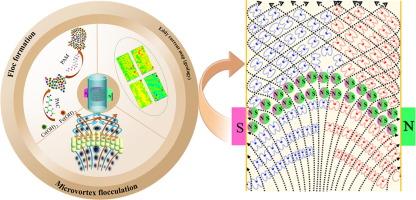Study on the flocculation mechanism of diverging microporous curved surface Micro-Vortex flocculation magnetic stable bed reactor and its purification of Cr(VI)-containing wastewater
IF 8.1
1区 工程技术
Q1 ENGINEERING, CHEMICAL
引用次数: 0
Abstract
In response to the contamination of water bodies by heavy metal pollution, particularly chromium (VI), this paper proposes a novel diverging microporous curved surface micro-vortex flocculation magnetic stable bed reactor for the treatment and purification of Cr(VI). The results show that under conditions of adding 0.0996 ∼ 1.373 mg/L FeSO4, 70 mg/L polyaluminum chloride (PAC), and 1.5 mg/L polyacrylamide (NPAM) respectively, and with an inlet flow rate of 0.023–2.101 m3/h for the reactor’s opposed-flow water distribution with different elevations, the removal rates of Cr(VI) and turbidity reach over 97 % and 99 %, respectively. By analyzing the instantaneous velocity vectors, streamlines, and vorticity distributions within the reactor using Particle Image Velocimetry (PIV) instruments, it is found that various turbulent flow patterns such as swirling flow, annular flow pattern, spiral flow, and water tongue flow are formed within the reactor. These flow patterns correspond to the generation of vortexes, micro-vortices, and micro-holes, resulting in a cascade flocculation phenomenon with their respective solid–liquid separation mechanisms. This makes the reactor a promising candidate for the treatment of heavy metal wastewater.

求助全文
约1分钟内获得全文
求助全文
来源期刊

Separation and Purification Technology
工程技术-工程:化工
CiteScore
14.00
自引率
12.80%
发文量
2347
审稿时长
43 days
期刊介绍:
Separation and Purification Technology is a premier journal committed to sharing innovative methods for separation and purification in chemical and environmental engineering, encompassing both homogeneous solutions and heterogeneous mixtures. Our scope includes the separation and/or purification of liquids, vapors, and gases, as well as carbon capture and separation techniques. However, it's important to note that methods solely intended for analytical purposes are not within the scope of the journal. Additionally, disciplines such as soil science, polymer science, and metallurgy fall outside the purview of Separation and Purification Technology. Join us in advancing the field of separation and purification methods for sustainable solutions in chemical and environmental engineering.
 求助内容:
求助内容: 应助结果提醒方式:
应助结果提醒方式:


